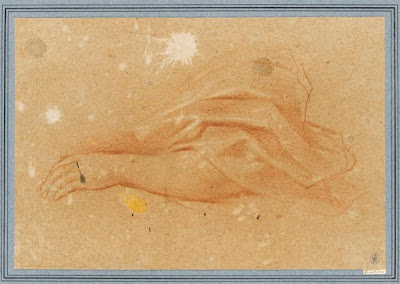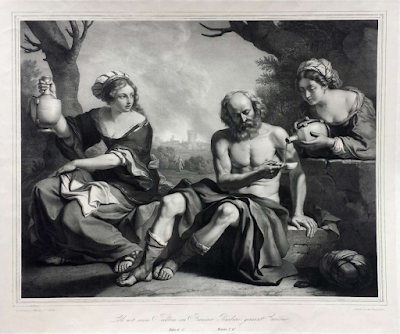 |
| Guercino (Giovanni Francesco Barbieri) Lot and his Daughters 1650 oil on canvas Gemäldegalerie, Dresden |
 |
| Guercino (Giovanni Francesco Barbieri) Lot and his Daughters 1650 drawing (compositional study) Royal Library, Windsor |
 |
| Guercino (Giovanni Francesco Barbieri) Lot and his Daughters 1650 drawing (drapery study - daughter at left) Staatsgalerie, Stuttgart |
 |
| Carl Straub after Guercino Lot and his Daughters 1852 lithograph British Museum |
 |
| Guercino (Giovanni Francesco Barbieri) Virgin and Child seated on Clouds ca. 1650 oil on canvas private collection |
"[Luigi] Salerno rightly suggested that [Virgin and Child seated on Clouds] may be a fragment from a larger picture, the commission for which had been cancelled. The incomplete lower half was presumably cut away and discarded. Like other unfinished pictures, or those ordered by patrons who had then defaulted, the canvas would probably have remained in the painter's studio."
 |
| Guercino (Giovanni Francesco Barbieri) Virgin and Child seated on Clouds ca. 1650 drawing (figure study - Christ Child) British Museum |
 |
| Guercino (Giovanni Francesco Barbieri) Mourning Virgin (Addolorata) ca. 1650 oil on canvas Patrizi Collection, Rome |
 |
| Guercino (Giovanni Francesco Barbieri) Mourning Virgin (Addolorata) ca. 1650 oil on canvas private collection |
"In [both versions of the Addolorata], the Virgin's veiled head, her sorrowful expression and her slightly plump hands held tightly together in prayer are similar. The present picture [directly above] is, however, more sombre and less fully painted than the other. The iconography of a sword embedded in the Virgin's breast is more specific than the generically devotional subject of the other canvas. Here Guercino has represented the subject traditionally referred to as the Virgin of the Seven Sorrows, with seven swords piercing her breast, symbolizing the range of her grief following Christ's Passion. . . . Guercino chose to depict only one sword (but blade, hand-guard and grip slightly misaligned, as was his wont with difficult linear perspective)."
 |
| Guercino (Giovanni Francesco Barbieri) Erminia finding the wounded Tancred 1650-51 oil on canvas Scottish National Gallery, Edinburgh |
 |
| Guercino (Giovanni Francesco Barbieri) Erminia finding the wounded Tancred 1650-51 drawing (figure study - Erminia) Scottish National Gallery, Edinburgh |
 |
| anonymous printmaker after Guercino Erminia finding the wounded Tancred 18th century etching (after Guercino drawing) British Museum |
 |
| Pietro Bonato after Guercino Erminia finding the wounded Tancred 1805 engraving British Museum |
 |
| Guercino (Giovanni Francesco Barbieri) St Anthony of Padua with the Infant Christ ca. 1650-51 oil on canvas Collegiata di San Giovanni Battista, San Giovanni in Persiceto |
 |
| Guercino (Giovanni Francesco Barbieri) Vocation of St Aloysius Gonzaga 1650-51 oil on canvas Metropolitan Museum of Art, New York |
 |
| Guercino (Giovanni Francesco Barbieri) Vocation of St Aloysius Gonzaga (detail) 1650-51 oil on canvas Metropolitan Museum of Art, New York |
"Aloysius [Luigi] Gonzaga (1568-91), the eldest son of Ferrante Gonzaga (1544-86), Marchese di Castiglione, resigned the marquisate in 1585 in favor of his younger brother and, after joining the Jesuits, devoted his life to helping the poor and sick. He died from the plague at age 23, was beatified in 1605 and was canonized in 1726 by Pope Benedict XIII (reg. 1724-30). Ferrante III Gonzaga (1617-78), Duke of Guastalla, commissioned this picture in 1650 for the Theatine church of Guastalla, S. Maria del Castello (now destroyed), to honour his ancestor and possibly to promote his canonization."
– quoted texts from The Paintings of Guercino: a revised and expanded catalogue raisonné by Nicholas Turner (Rome: Ugo Bozzi Editore, 2017)